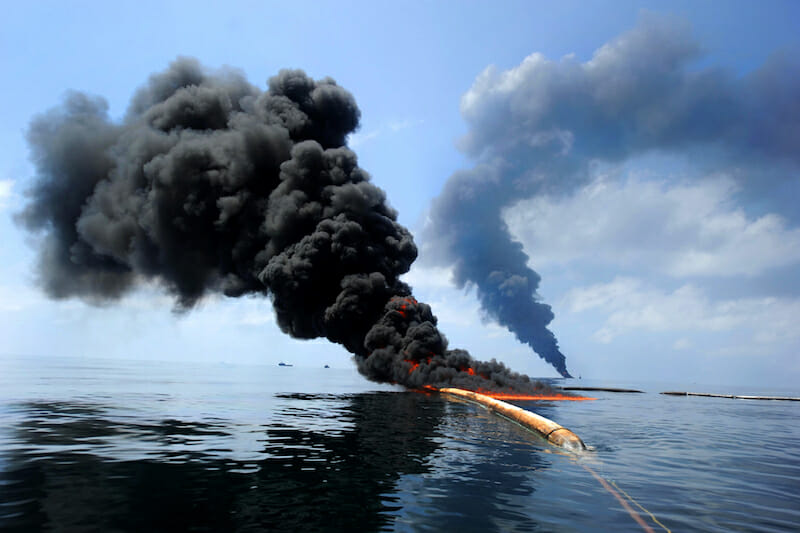Background on Taylor Energy and BP Oil Spills
Both of these oil spills, Deepwater Horizon and Taylor Energy, are two of the biggest oil spills in history and their consequences are still prevalent today. The BP oil spill is the largest marine oil spill in history. On the night of April 20, 2010 a surge of natural gas blasted through a concrete core on the oil rig, Deepwater Horizon, which resulted in an explosion killing 11 people and injuring 17 (Pallardy).

Satellite image of Deepwater Horizon Oil Spill. Source By: NASA [Public Domain].
The rig capsized and sunk on the morning of April 22, 2010 (Pallardy). It continued leaking oil, for nearly four months until it was effectively capped on July 15, 2010. During that time, it is estimated one hundred and thirty four million barrels of oil was released into the ocean (Pallardy). The clean up efforts after the explosion were massive and incremental. To clean up the oil from the open water,”1.8 million gallons of dispersants—substances that emulsified the oil, thus allowing for easier metabolism by bacteria—were pumped directly into the leak and applied aerially to the slick” (Pallardy). Most of the oil was siphoned-off or burned, however, the remaining oil that made it to land was manually removed. Roughly 1,300 miles of US coastline from Louisiana to Florida was covered in oil, an estimated 800,000 birds and 65,000 turtles were killed by the oil, and BP had to pay out over $65 billion in compensation to the people impacted by the oil spill (Pallardy).
The Taylor oil spill began in 2004, after hurricane Ivan destroyed the MC20 oil rig operated by Taylor Energy and is still leaking oil into the Gulf today. It is the longest continuous oil spill in American history (Villafranca). The Taylor oil spill was discovered during the cleanup of the Deepwater Horizon spill. The average oil coverage area is roughly 6 square miles (Sun). They suggest the cumulative oil-contaminated area is roughly 735 square miles around the site (Sun). The average oil discharge rate is around 48 to 1700 barrels a day (Sun). Taylor energy has spent as much as $435 million in decommissioning the site. Taylor energy has claimed they have done everything they could do to contain the spill. However, many believe the site is still active and believe Taylor energy should do more to completely stop the leak. It has been largely unpublicized until recently, when reports started emerging that the spill has dumped more than 241 million barrels of oil into the Gulf of Mexico (Baurick).
Coverage of the Deepwater Horizon Oil Spill. Source By: Youtube [Public Domain].
Coverage of Taylor Energy oil spill off coast of Louisiana. Source By: Youtube [Public Domain].
Sources:
Baurick,T. “14-Year Taylor Energy Oil Leak Could Prove Larger than BP Spill, New Research Says.” Nola.com, Nola.com, 15 Feb. 2019.
Pallardy, Richard. “Deepwater Horizon Oil Spill.” Encyclopædia Britannica, Encyclopædia Britannica, Inc., 13 Apr. 2019.
Sun, Shaojie. “Remote sensing assessment of oil spills near a damaged platform in the Gulf of Mexico” Marine Pollution Bulletin, Chuanmin Hu, Oscar Garcia-Pineda, Vassiliki Kourafalou, Matthieu Le Henaff, Yannis Androulidakis, vol. 136, November 2018, pp. 141-151.
Villafranca, Omar. “Oil Spill Still Leaking into the Gulf of Mexico 15 Years Later.” CBS News, CBS Interactive, 15 Mar. 2019.
